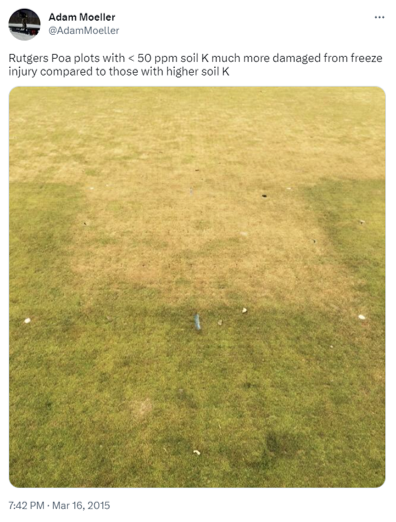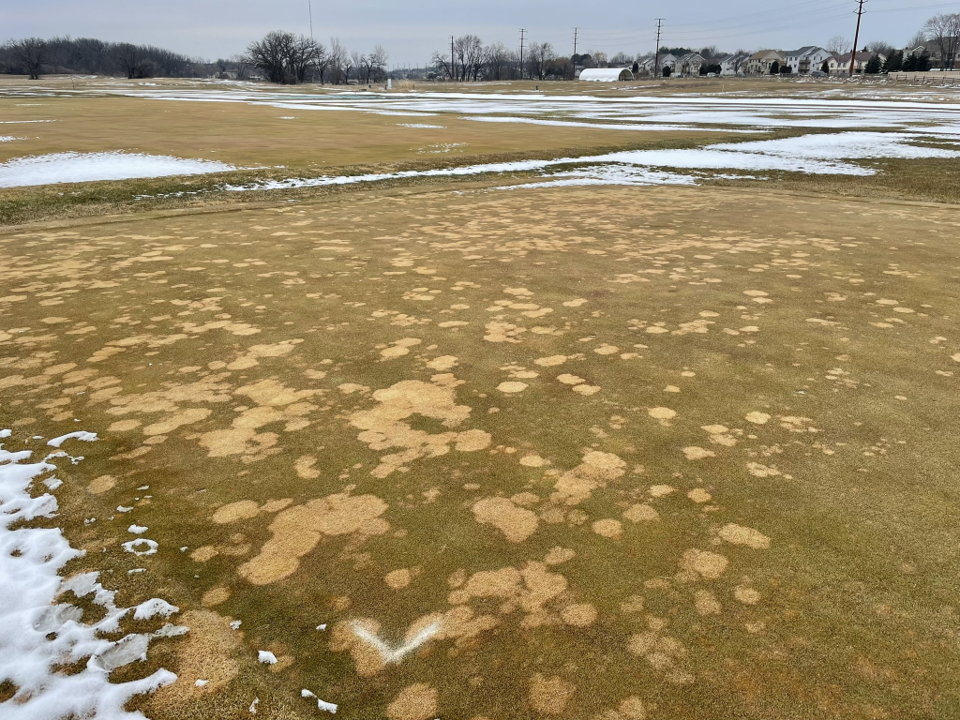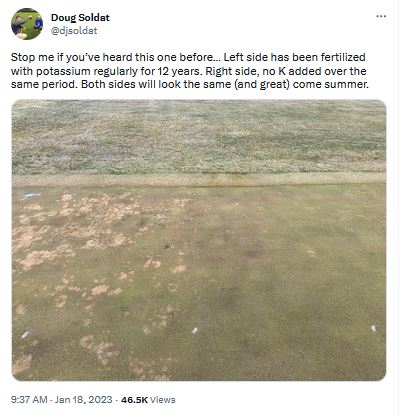By Doug Soldat, Professor, Department of Soil Science, University of Wisconsin-Madison, [email protected]
Potassium nutrition and disease interactions is one of the more exciting areas of turfgrass science. Traditionally, nutrient deficiency is defined by agronomic responses. For example, if you apply a nutrient and your grass growth, color, or density are improved, then the nutrient was deficient. By this definition, turfgrass is in a state of perpetual nitrogen deficiency because nitrogen additions rarely fail to affect growth, density, or color. However, it is quite rare to see growth, density, or color responses to potassium. Back in 2001, researchers at the University of Connecticut published a blockbuster research paper that demonstrated how creeping bentgrass is able to obtain all the potassium it needs from most sandy soils in a greenhouse setting. I was part of a team that documented similar findings with creeping bentgrass on a sand green in a field setting (Bier et al., 2018). The WinterTurf project is investigating potassium acquisition from other turf types and non-sandy soils.

Here is where things get interesting. While not very exciting for growth, potassium fertilization affects certain aspects of turfgrass health, but these impacts require an outside agent or a particular set of conditions. For example, potassium can affect plant cold tolerance, but cold tolerance must exist – no cold, no impact. Rutgers University researchers have documented winterkill from low levels of potassium on annual bluegrass and others have shown bermudagrass winterkill is affected by potassium fertilization (Schmid et al., 2016; Figure 1 from @AdamMoeller). There are, however, no reports of potassium affecting winter survivability of bentgrass, perhaps because bentgrass is quite tolerant of low temperature winterkill.

Similarly, potassium affects the incidence and severity of many diseases (Figure 2). Rutgers University researchers documented that annual bluegrass turf with low potassium status had more severe anthracnose (Schmid et al., 2018). In my work, low potassium has not influenced anthracnose, but creeping bentgrass is not susceptible to anthracnose in my climate. Many researchers have observed that potassium fertilization enhances snow mold severity (Figure 3 from @djsoldat). Yet, you won’t see that effect if the fungicide program is adequate or the environmental conditions for snow mold didn’t occur.

All this is to say that the positive and negative consequences of potassium fertilization are determined by grass species, pathogens, and environmental conditions, and making a correct decision about potassium fertilization will depend on our scientific understanding of these complex factors. The WinterTurf research project is striving to improve our understanding the complicated ways that potassium influences winter disease and winter survivability of turfgrasses. Stay tuned for more!
References
Bier, P.V., Persche, M., Koch, P. and Soldat, D. 2018. A long term evaluation of differential potassium fertilization of a creeping bentgrass putting green. Plant Soil 431, 303–316. https://doi.org/10.1007/s11104-018-3765-8
Schmid, C.J., Murphy, J.A., Clarke, B.B., DaCosta, M. and Ebdon, J.S. 2016. Observations on the effect of potassium on winter injury of annual bluegrass in New Jersey in 2015. Crop, Forage & Turfgrass Management, 2: 1-4 cftm2015.0170. https://doi.org/10.2134/cftm2015.0170
Schmid, C.J., Clarke, B.B. and Murphy, J.A. 2018. Potassium nutrition affects anthracnose on annual bluegrass. Agronomy Journal, 110: 2171-2179. https://doi.org/10.2134/agronj2018.03.0147